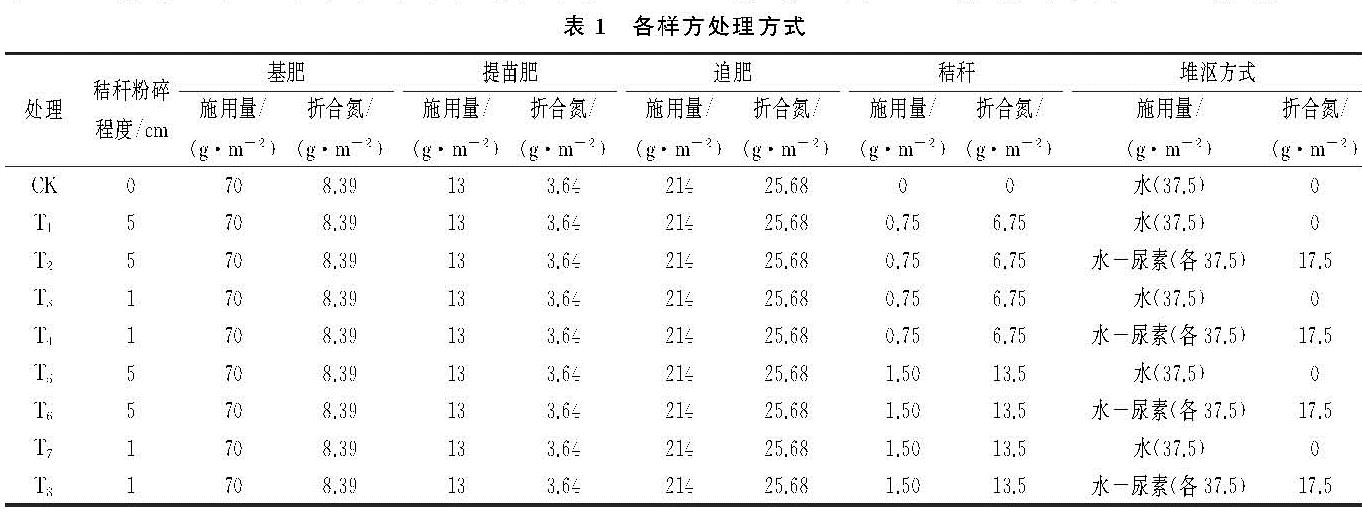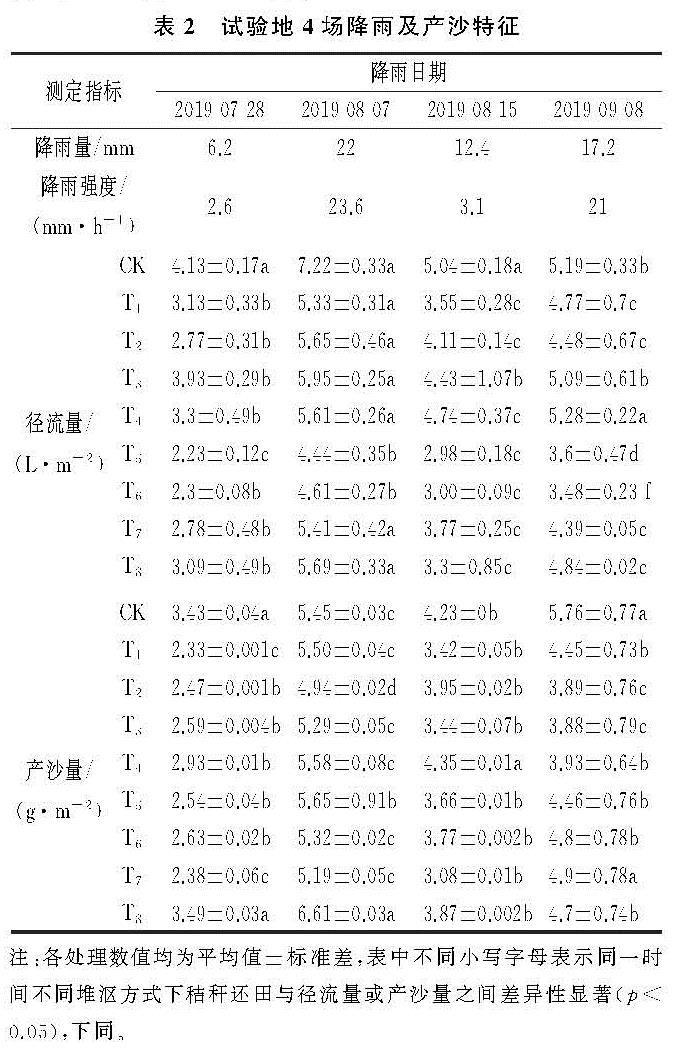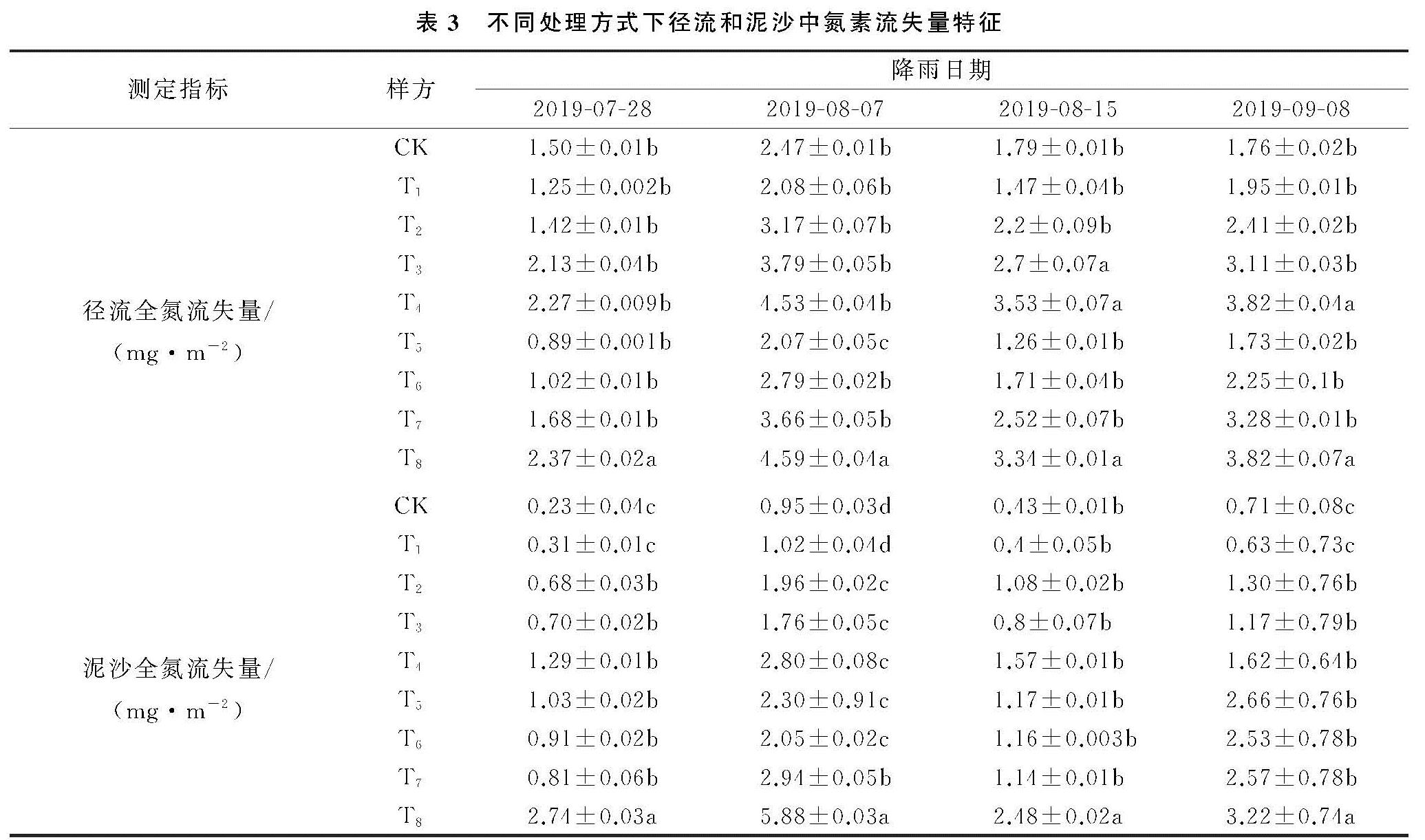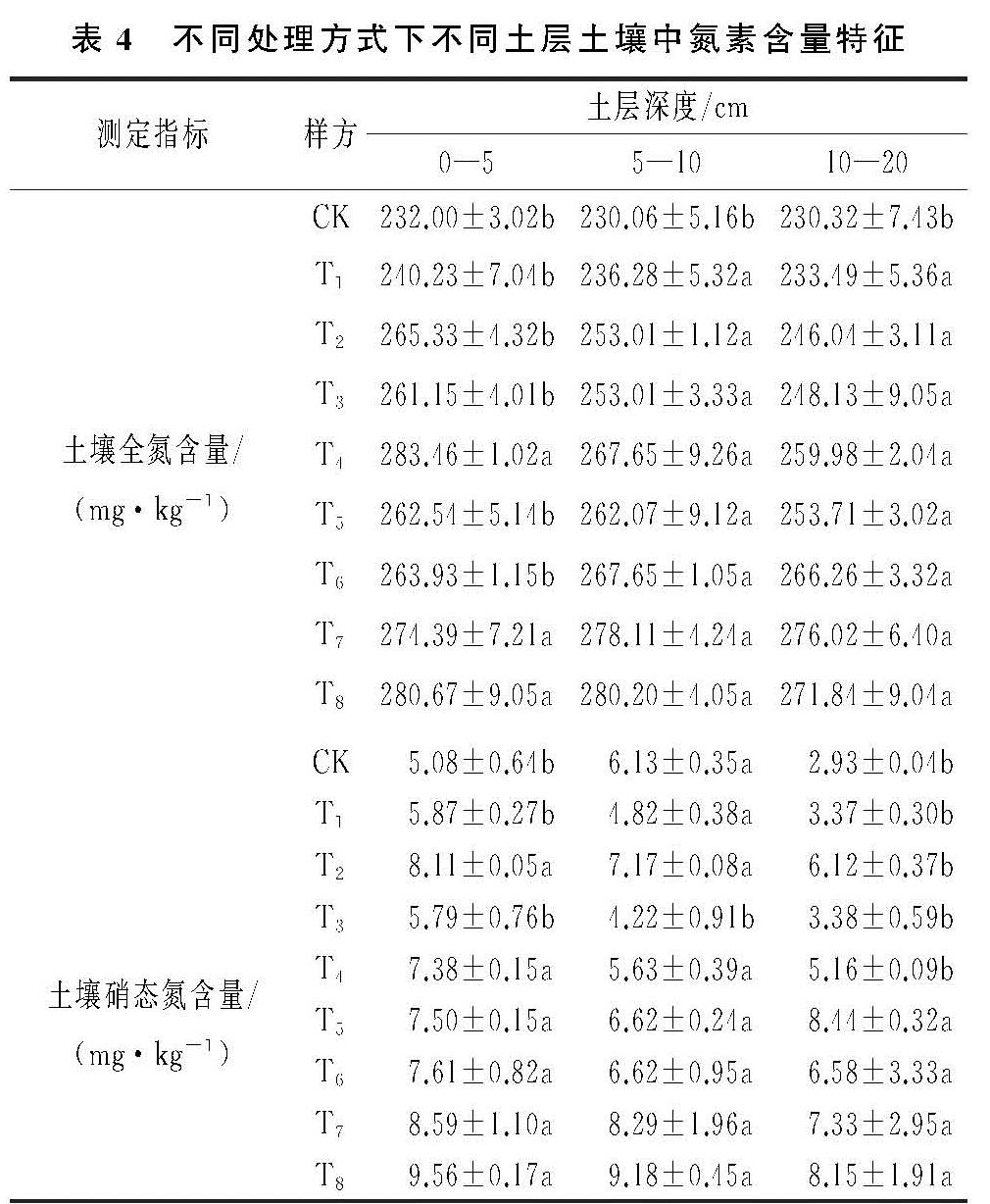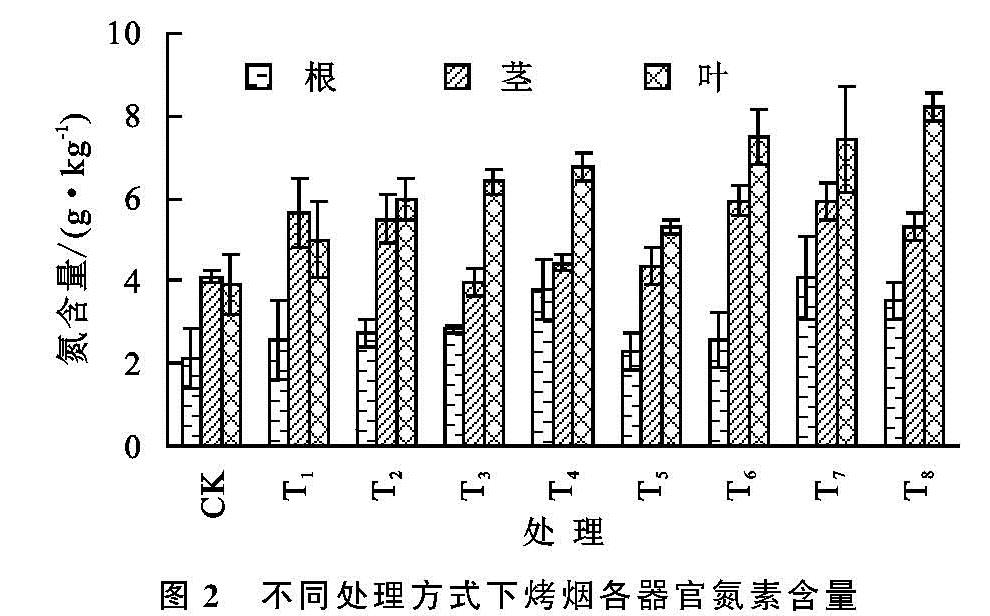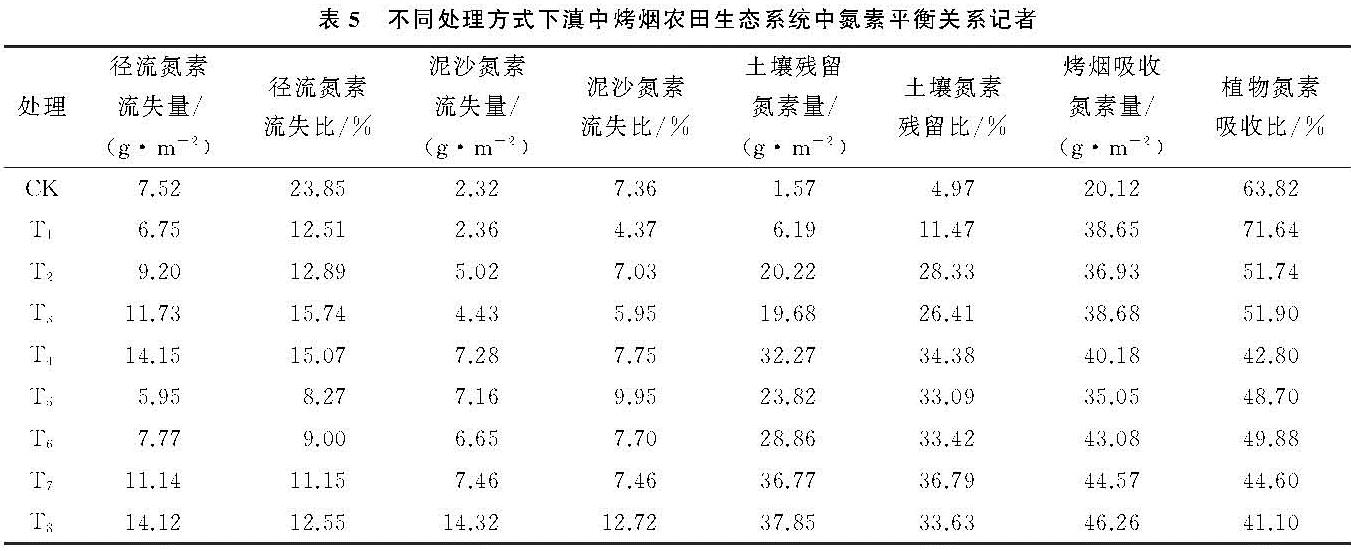2.1 径流、泥沙中氮素流失特征分析
2.1.1 不同降雨下各样方产流产沙特征 试验期间出现了4次较大的降雨,分别在7月28日、8月7日、8月15日和9月8日,降雨量分别为6.2,22,12.4,17.2 mm,最大雨强分别为2.6,23.6,3.1,21 mm/h。各处理样方的产流量均小于CK,不同堆沤方式下的秸秆还田对各样方产流量影响不同(表2):施用1.5 kg/m2秸秆的样方(T5,T6,T7,T8)较施用0.75 kg/m2秸秆的样方(T1,T2,T3,T4)产流量减少19.90%~22.87%; 施用秸秆粒度5 cm的样方(T1,T2,T5,T6)较施用秸秆粒度1 cm的样方(T3,T4,T7,T8)产流量减少19.90%~22.87%,说明秸秆还田量为1.5 kg/m2,秸秆粒度为5 cm可有效减少径流流失量。就4次降雨来看,各样方产流量均表现为8月7日>9月8日>8月15日>7月28日,表明降雨量与产流量呈正相关关系。
不同堆沤方式下的秸秆还田对坡耕地产沙量的影响表现为:4次降雨中8月7日和9月8日降雨强度较大,8月15日次之,7月28日最小,各样方产沙量均表现为8月7日>9月8日>8月15日>7月28日,表明降雨强度与产沙量呈正相关。8月7日各处理土壤侵蚀量均值为5.51 g/m2,为其他降雨日期的1.22~2.00倍。就不同处理来看:除T8外,各处理产沙量均低于CK,其中施用0.75 kg/m2秸秆的样方(T1,T2,T3,T4)较施用1.5 kg/m2秸秆的样方(T5,T6,T7,T8)产沙量减少6.56%~32.59%; 施用秸秆粒度5 cm的样方(T1,T2,T5,T6)较施用秸秆粒度1 cm的样方(T3,T4,T7,T8)产沙量减少1.77%~13.15%。
2.1.2 径流和泥沙中全氮流失浓度及流失量特征 从图1可以看出,各处理方式全氮流失浓度均高于CK,T8样方全氮流失浓度在径流泥沙中均最大。不同处理的径流泥沙全氮流失浓度存在显著性差异(p<0.05),径流中的全氮流失浓度变化幅度高于泥沙。
径流中的全氮流失浓度变化呈梯度变化,施用1.5 kg/m2秸秆的样方(T5,T6,T7,T8)径流全氮流失浓度较施用0.75 kg/m2秸秆的样方(T1,T2,T3,T4)高出2.40%~18.43%; 施用1 cm细秸秆样方(T3,T4,T7,T8)径流全氮流失浓度较施用5 cm粗秸秆的样方(T1,T2,T5,T6)高出46.80%~53.50%; 添加尿素堆沤的样方(T2,T4,T6,T8)全氮浓度较未添加尿素堆沤秸秆还田的样方(T1,T3,T5,T7)高25.56%~32.66%。
泥沙中施用1.5 kg/m2秸秆的样方(T5,T6,T7,T8)泥沙全氮流失浓度比施用0.75 kg/m2秸秆的样方(T1,T2,T3,T4)高73.00%~142.06%; 施用1 cm细秸秆样方(T3,T4,T7,T8)泥沙全氮流失浓度比施用5 cm粗秸秆的样方(T1,T2,T5,T6)高出44.39%~72.72%; 添加尿素堆沤的样方(T2,T4,T6,T8)全氮流失浓度比未添加尿素堆沤的样方(T1,T3,T5,T7)高出54.38%~87.62%。
4次降雨中,7月28日、8月7日、8月15日和9月8日各处理中径流全氮流失量分别为1.25~2.37,2.08~4.59,1.47~3.34,1.76~3.82 g/m2; 泥沙全氮流失量分别为0.23~2.74,0.95~5.88,0.43~2.48,0.71~3.22 mg/m2。方差分析表明,不同处理方式下径流与泥沙全氮流失量差异性显著(p<0.05),氮素流失以径流流失为主,泥沙流失为辅。
在不同降雨条件下,径流全氮流失量存在规律性变化:8月7日降雨量达到22 mm时,各处理的全氮流失量均最大,9月8日次之,7月28日、8月15日最小。
在不同处理方式下:施用1.5 kg/m2秸秆样方(T5,T6,T7,T8)比施用0.75 kg/m2样方(T1,T2,T3,T4)径流全氮含量降低0.32%~35.05%; 施用5 cm粗秸秆样方(T1,T2,T5,T6)比施用1 cm细秸秆样方(T3,T4,T7,T8)的径流全氮含量降低54.52%~77.23%; 添加尿素堆沤的样方(T2,T4,T6,T8)比未添加尿素堆沤的样方(T1,T3,T5,T7)的径流全氮含量高出28.40%~49.00%。说明1.5 kg/m2秸秆还田量较0.75 kg/m2,5 cm粗秸秆还田较1 cm细秸秆还田均可有效减少径流氮素流失量。
图1 不同堆沤方式下径流全氮和泥沙全氮流失浓度特征
在不同降雨条件下,泥沙全氮流失量在8月7日达到峰值(2.50 g/m2),是其他降雨条件的1.37~2.50倍。在不同处理方式下,T8样方泥沙全氮流失量远高于其他处理样方,为其他处理的1.92~6.17倍。施用1.5 kg/m2秸秆的样方(T5,T6,T7,T8)比施用0.75 kg/m2的样方(T1,T2,T3,T4)泥沙全氮流失量高出94.82%~208.37%; 施用秸秆粒度5 cm的样方(T1,T2,T5,T6)比施用秸秆粒度1 cm的样方(T3,T4,T7,T8)泥沙全氮含量降低了29.01%~97.41%; 添加尿素堆沤的样方(T2,T4,T6,T8)比未添加尿素堆沤的样方(T1,T3,T5,T7)泥沙全氮流失量高出87.01%~197.62%(表3)。
2.2 土壤中氮素储存特征
在烤烟收获后,各处理样方土壤全氮、硝态氮含量分别是CK的1.02~1.20倍、1.19~1.48倍,表明不同秸秆还田方式均会增加土壤全氮和硝态氮含量。秸秆还田后不同土层全氮含量存在差异,在施用0.75 kg/m2的秸秆的样方(T1,T2,T3,T4)土壤全氮含量总体随着土层深度增加而减小; 施用1.5 kg/m2秸秆的样方(T5,T6,T7,T8)呈现为:5—10 cm土层土壤全氮含量最大,其次为0—5 cm土层,10—20 cm土层最小。
不同处理方式秸秆还田在不同土层中对土壤全氮量影响不同。施用1.5 kg/m2秸秆的样方(T5,T6,T7,T8)较施用0.75 kg/m2秸秆的样方(T1,T2,T3,T4)在0—5,5—10,10—20 cm土层中分别高出3.21%,7.57%和7.73%,且对5—10,10—20 cm土层土壤全氮量增加效果显著; 施用1 cm细秸秆的样方(T3,T4,T7,T8)较施用5 cm粗秸秆的样方(T1,T2,T5,T6)在0—5,5—10,10—20 cm土层中分别高出6.60%,5.84%和5.49%,但对土壤全氮量增加效果无明显差异; 添加尿素堆沤的样方(T2,T4,T6,T8)全氮含量较未添加尿素堆沤的样方(T1,T3,T5,T7)在0—5,5—10,10—20 cm土层中分别高出5.45%,3.86%,3.25%,且增加效果显著。
秸秆还田后,土壤硝态氮含量随着土层深度增加而降低,不同处理之间,硝态氮含量存在显著性差异(p<0.05)。不同堆沤方式秸秆还田在不同土层中对土壤硝态氮影响不同。施用1.5 kg/m2秸秆的样方(T5,T6,T7,T8)较施用0.75 kg/m2秸秆的样方(T1,T2,T3,T4)在0—5,5—10,10—20 cm土层中分别高出24.86%,47.30%和83.22%,且对10—20 cm土层土壤硝态氮含量增加效果显著; 施用秸秆粒度1 cm的样方(T3,T4,T7,T8)较施用秸秆粒度5 cm的样方(T1,T2,T5,T6)在0—5,5—10,10—20 cm土层中分别高出46.27%,34.76%和20.79%,且对0—5 cm土层土壤硝态氮含量增加效果最好; 添加尿素堆沤的样方(T2,T4,T6,T8)较未添加尿素堆沤的样方(T1,T3,T5,T7)在0—5,5—10,10—20 cm土层中分别高出19.57%,23.19%和30.72%,说明添加尿素堆沤对10—20 cm土层土壤硝态氮含量影响最大(表4)。
2.3 植物体内氮素吸收量
在烤烟收获期,不同处理中烤烟各器官全氮含量总体表现为叶>茎>根,秸秆还田较CK分别增加了67.69%,25.33%和42.27%,不同处理对叶、根氮含量影响较大,对茎的影响较小。不同堆沤方式下,植物全氮含量呈现规律性变化:秸秆还田量1.5 kg/m2的样方(T5,T6,T7,T8)烤烟植物体含氮量较秸秆还田量0.75 kg/m2的样方(T1,T2,T3,T4)高出1.46%~34.55%; 秸秆还田粒度1 cm的样方(T3,T4,T7,T8)烤烟植物体全氮含量较秸秆还田粒度5 cm的样方(T1,T2,T5,T6)高出2.54%~35.77%; 同时添加尿素堆沤的样方(T2,T4,T6,T8)烤烟植物体全氮含量较未添加尿素堆沤的样方(T1,T3,T5,T7)高出6.60%~38.03%。综上,在进行秸秆的堆沤还田时,秸秆还田粒度为1 cm,还田秸秆量为1.5 kg/m2,添加尿素均可有效增加植物各器官全氮含量(图2)。
2.4 烤烟坡耕地氮平衡关系
根据宋娅丽[18]对农田生态系统氮素平衡的计算公式,化肥及有机肥氮素输入量=径流与泥沙氮流失量+土壤残留氮量+烤烟吸收量。径流氮素流失量占氮素输入量的8.27%~23.85%,泥沙氮素流失量占氮素输入量的4.37%~12.72%,土壤氮素残留量占氮素输入量的4.97%~36.79%,烤烟吸收量占氮素输入量的41.10%~71.64%。数据表明烤烟吸收的氮素占氮素输入的主体部分。氮素流失主要以径流为主,泥沙为辅,两者的流失量之和占氮素输入量的16.89%~31.21%。就径流氮素流失量来看,秸秆还田处理的样方氮素流失量与氮素输入量的比值均低于CK,说明秸秆还田可以有效减少径流氮素流失。
施用1.5 kg/m2秸秆样方(T5,T6,T7,T8)氮素平均流失量占氮素输入量的19.69%,施用0.75 kg/m2秸秆的样方(T1,T2,T3,T4)氮素平均流失量占氮素输入量的20.33%,表明施用1.5 kg/m2秸秆较施用0.75 kg/m2秸秆可有效减少氮素流失; 秸秆粒度为5 cm的样方(T1,T2,T5,T6)总体氮流失量占氮素输入量的16.70%~19.92%,秸秆粒度为1 cm的样方(T3,T4,T7,T8)总体氮流失量占氮素输入量的18.61%~25.27%,表明秸秆粒度为5 cm较秸秆粒度1 cm同样可有效减少氮素流失; 添加尿素堆沤的样方(T2,T4,T6,T8)平均氮素流失量占氮素输入量的21.18%,未添加尿素堆沤样方(T1,T3,T5,T7)的平均氮素流失量占氮素输入量的18.84%,表明尿素的添加会增加氮流失。
就植物吸收来看,2号样方植物氮素吸收量与氮素输入量的比值最高达到71.64%,T8样方的比值最小为41.10%。在氮的输入量达到71.98 g/m2时,烤烟吸收氮素量与氮素输入量的比值下降,土壤氮素残留量与氮素输入量的比值上升(表5)。
表5 不同处理方式下滇中烤烟农田生态系统中氮素平衡关系记者
